 |
MNX FacilityThe MNX device represents the fourth use of experimental equipment constructed more than 40-years ago. The magnet coils were first used for basic plasma studies of lower-hybrid wave propagation and parametric instabilities. The second use was for spacecraft-glow research. The coils were then used for studies of detached plasmas relevant to tokamak divertors. The MNX is now used to study expansion of plasmas through strong gradients in magnetic fields. Figure 1 shows the MNX configuration, with plasma expanding into a Pyrex section. The MNX axial magnetic field is provided by a Helmholtz pair of 22 water-cooled coils, which provide an axial field up to 3.5 kG. A single magnetic nozzle coil is located coaxial with one of the Helmholtz coils. It can be run to 2.5 kG in steady state, or pulsed to 25 kG for 30 ms. The MNX main chamber is stainless steel and the expansion region is Pyrex. Inside the Pyrex pipe are a set of 15 copper rings that may be electrically biased. A 1-kW helicon radio-frequency (rf) system, operating at 27 MHz, is used to create steady-state plasmas about 3 cm in diameter in the main chamber. Helicon waves are launched by a saddle-type antenna (Figure 2). The plasma flows through the main chamber. Figure 3, taken through a 12-cm diameter window, shows an argon plasma in the main section of MNX. This plasma is in the "so-called" blue core mode. The plasma diameter is about 3 cm. The plasma exits the main chamber through an aperture, seen in a mirror, attached to the nozzle coil. The plasma species may be readily changed; the inert gases are the most commonly used. A plasma density up to 1014 cm-3 and a maximum temperature of about 7 eV (~80,000 K) have been achieved. The movie (3.9 MB) shows the change in appearance of the plasma column as Helium gas is added to an Argon plasma. Figure 4 shows an argon plasma exhausting through the nozzle (right) of the MNX facility into the expansion chamber, a multi-port Pyrex vessel (left). Note the change in color between the plasma in the main chamber (blue, Figure 3) and in the expansion chamber (rose). For some experiments a small aperture was placed downstream of the nozzle coil. The red halo (Figure 5) around the aperture is from the diode laser used in the West Virginia University (WVU) laser-induced fluorescence (LIF) system. Changing the gas pressure in the expansion chamber is shown in this movie (4.0 MB). The MNX diagnostic systems include: Radio-frequency power measurements, scanning Langmuir probes, a multi-chord visible spectrometer with iCCD camera detector, and a LIF system for ion temperatures measurement and turbulence studies. Inserting probes into the plasma alters the plasma — the probe sucks energy out of the plasma and a shadow develops downstream to the left [Figure 6; movie (3.1 MB)]. Links |
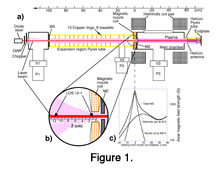 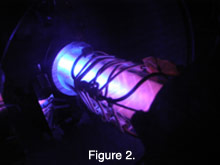 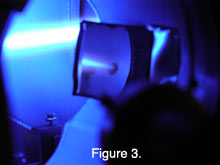  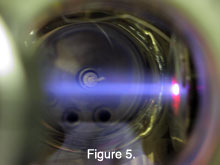 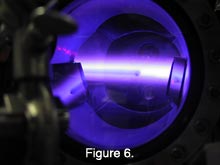
|
Contact: Professor Samuel A. Cohen |
PPPL is funded by the USDOE Office of Science |